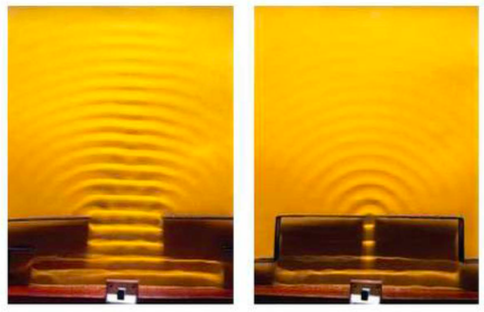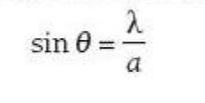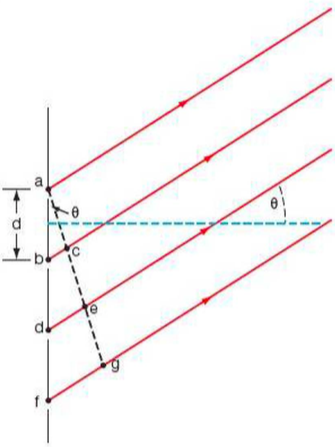Diffraction
Introduction
⇒ When waves pass through a gap or move past an obstacle, they spread out (i.e. diffract)
⇒ Diffraction happens when waves spread around an obstacle or through a gap
⇒ Diffraction is most pronounced if it is of a similar order of magnitude (i.e. similar size) as the obstacle or gap

Diffraction of Light
⇒ Visible light has an extremely short wavelength so diffraction is only significant if the slit is very narrow
⇒ When light diffracts though a single slit, a fringe pattern on a screen can be seen with a central bright fringe and less bright fringes each side
- Note, the reason there is such interference patterns with a single slit is due to the Huygens-Fresnel principle, which states that every point on a wavefront is a source of wavelets (i.e. small diffracting waves)
⇒ These bright fringes (called maxima) are due to constructive interference
⇒ The dark fringes in between (minima) are due to destructive inteference
⇒ The width of the central maximum depends on the wavelength of the light and the slit width
- The edges of the central maxima (i.e. the start of the first minimum) occurs at an angle given by the following formula:


⇒ As the wavelength of light increases, the central maximum becomes wider.
⇒ As the slit width increases, the central maximum becomes narrower

⇒ If white light is used and diffracted through a single slit, the fringes are coloured because white light contains a mix of colours
- Since the central maximum depends on the ratio between the wavelength of the light and the slit width, the central maximum will be broader for red light than blue light (as red light has a longer wavelength)
Diffraction Gratings - Required Practical
⇒ Interference patterns can be seen using diffraction grating, which has thousands of slits spaced very closely together
⇒ As the slits are so narrow, the light diffracts at a wide angle
⇒ The resulting pattern is due to the light superposing and interfering from the slits
- At the point where the light passes through the slits, the path difference between each slit is zero, so the light at this point is in phase and the overlapping waves combine to form a maximum intensity
- Either side of the central maximum other maxima are produced - the first order maximum is seen when the path difference for waves leaving adjacent slits is one wavelength
⇒ For the first order maxima:
- Interference is constructive
- The path difference of light from adjacent slits is one wavelength
- Light travels at angle θ1 to the direction of incident light

⇒ Applying this information to the triangle abc above:

⇒ In general, the conditon for maximuma to occur is given by:

Applications of Diffraction Gratings
⇒ They are used to separate light of different wavelengths at great detail (i.e. in a high resolution)
⇒ This can be used as part of a spectrometer, which is used to investigate atomic spectra
⇒ It can also be used in telescopes to analyse light from another galaxy
Extra
⇒ Also see our notes on: